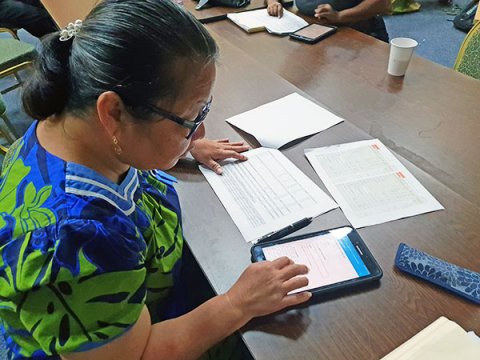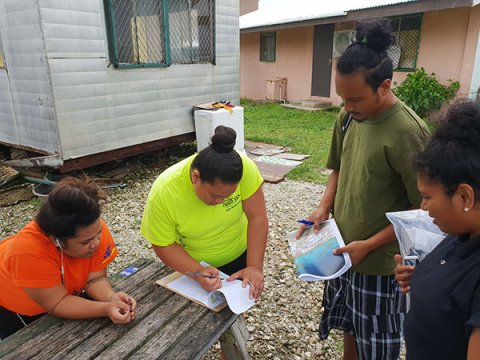Optimising the collection of socioeconomic data in the Pacific
Field operations for the household income and expenditure survey (HIES) experiment – the HIES experiment – began this week. The experiment is being conducted in the Republic of the Marshall Islands (RMI) with the objective to identify optimal methodologies to collect household consumption and expenditure data for use in economic and social policy formation. The experiment will be implemented over the coming four months across six atolls in RMI, including the densely populated urban atolls of Kwajalein and Majuro, and four remote rural atolls.
The project is being implemented by the Economic Policy, Planning and Statistics Office (EPPSO) of RMI, the World Bank and the Pacific Community (SPC), with all three agencies contributing technically and financially. SPC’s financial contribution was a co-investment by SPC and the Government of New Zealand, through the Ministry of Foreign Affairs and Trade, who are, along with EPPSO and the World Bank, gratefully acknowledged. The project has a number of collaborating technical partners, including: the International Labour Organisation (ILO), the United Nations Children’s Fund (UNICEF), the Food and Agriculture Organisation of the United Nations (FAO), the University of Waikato and Statistics-New Zealand; along with the World Bank Group’s Poverty Global Practice and the Pacific Community’s Statistics for Development Division.
Household Income and Expenditure Survey (HIES) – in one form or another – are conducted in all regions of the world with the purpose to collect data for national economic and social applications. Since 2011, majority of the Pacific Island countries and territories (PICTs) have implemented a regionally standardised HIES methodology.
However, considering the unprecedented demand for regular disaggregated development statistics and given the available of new technology, it is necessary to conduct a HIES methodological experiment to ensure an optimal survey method, which efficiently produce high quality data, are available in the Pacific region. The HIES experiment will also test the inclusion of new questionnaire modules to collect complementary data to get more out of this regular nationally representative statistical collection.
The results of the HIES experiment will be used to guide the HIES methodology that RMI will implement in the upcoming 2019 HIES. They will also form the basis to further develop the Pacific regionally standardised HIES, so the project will be of benefit to RMI and the wider Pacific region.
With the HIES producing such a diverse set of information across multiple sectors and its use to monitor and measure progress against national, regional and global priority areas (including populating a good handful of the Pacific Sustainable Development Goal (SDG) Indicators), it’s important that data quality and statistical best practice is prioritised.
The methodological aspect of the HIES experiment will test different ways to collect consumption data. In the current standard Pacific HIES, apparent (as opposed to direct) consumption data is collected through households completing a two-week food acquisition diary. It has been observed that diary response rates diminishes over the two-week diary period, indicating respondent fatigue and/or poor survey management, ultimately undermining data quality.
There are five different methodological approaches being implemented, each being used to measure household food acquisition through various diary and recall-based approaches.
High quality consumption data will allow for the identification vulnerable and impoverished populations and to estimate prevalence of over and undernourishment (SDG indicator 2.1.1) and to inform policy to combat regional issues, such as wellbeing, stunting, food insecurity and healthy lifestyles.
Kristen Himelein Kastelic, Senior Economist / Statistician, World Bank Group, says “the global community considers ending extreme poverty to be such an important objective that it is the first Sustainable Development Goal, but without high quality data, we will never know how close we are to achieving this objective. At the national level, high quality data is essential to ensure that programs and services have sufficient resources and are properly targeted. This experiment is essential to helping countries make efficient use of scarce resources to collect the best possible data.”
In order to meet demand for more dynamic data and to eliminate the need to conduct stand-alone surveys, the below new survey modules have been added to the core HIES questionnaire.
- Food acquired and consumed outside of the household, such as at restaurant and takeaway venues, which are anecdotally identified as being a significant source of calories across the Pacific region and a food source that is thought to be poorly measured through the use of the current food acquisition diary.
- Enhanced labour module to collect age and gender disaggregated labour market data, such as employment.
- The Food Insecurity Experience Scale to measure experiences of moderate-to-severe food insecurity and to report against SDG indicator 2.1.2.
- Household exposure to shocks through adverse environmental, economic and social change, and the affect and response to issues such a drought, natural disaster and adverse social events.
- A new disability module to identify vulnerable populations, including children and women.
- Enhanced health and fisheries modules.
The HIES experiment will use paper and digital (i.e., using tablets) instruments to collect data and it will test the use of satellite technology as a means to capture and back-up data over the internet in the context, and under the constraints, of remote island atolls.
The project is being conducted in RMI in order to inform the method and protocols to adopt in the 2019 HIES, and to enhance the capacity of EPPSO to implement complex statistical collections. RMI is also an ideal location given the diverse household economic environment and household income and expenditure sources, and consumption behaviour, throughout RMI.
The collection of data will commence on 16 July and conclude around mid-October 2018. After completion of field operations, technical collaborating agencies will be engaged to analyse the data to draw conclusions as to the most efficient means to collect consumption data and to identify whether the new modules meet data user demand. The conclusions and the recommendations will be presented to the newly established Pacific Statistics Methods Board early in 2019 and, subject to endorsement by the board, the recommended methodology will be synthesised and disseminated to PICTs for implementation when conducting HIES under the 2030 Agenda for Sustainable Development.
SPC’s Director of the Statistics for Development Division, Ofa Ketuu, says “Untested change of statistical methods and systems is a complex and costly process and the data may not deliver the required outcome of producing timely quality data at lower cost.
“The results from this HIES project will help the Pacific statistical system to make well-informed decisions on which method and system to adopt when conducting HIES”.
“Wherever possible, the process of testing and validation should be followed for any new statistical method or system that is introduced to the region, which will help to ensure that they are fit for purpose and implemented according to statistical best practice”. This project is an example of collaboration among Pacific Island countries and territories, and technical and financial partners, to achieve a common agenda to produce high quality data to guide decision making and policy formation.
Contact: Michael Sharp, Economic Adviser, Statistics for Development Division, SPC

